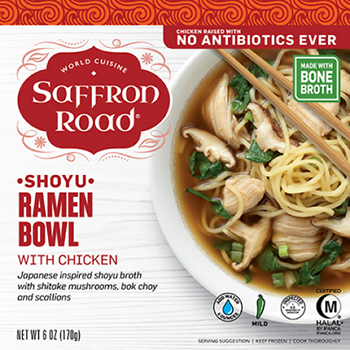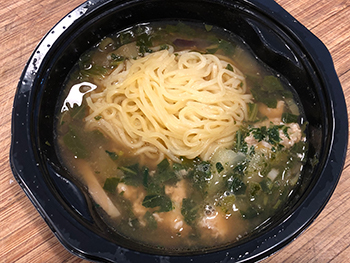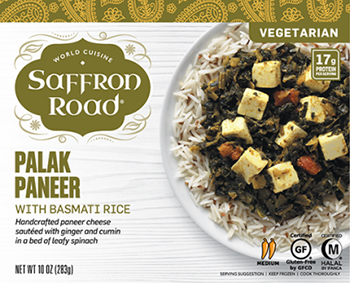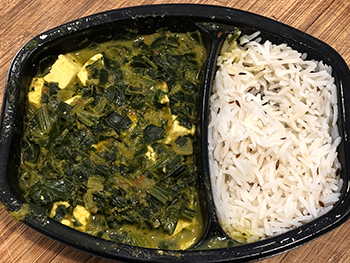Dr. Gourmet's Food Reviews
Saffron Road Food Palak Paneer
Shoyu Ramen Bowl with Chicken and Palak Paneer

A few weeks ago we discovered a new line of products from Saffron Road: ramen bowls. They were intriguing, but unfortunately the execution didn't live up to the idea: both the Vegetable Tan Tan Ramen Bowl with Tofu and the Tan Tan Ramen Bowl with Chicken were way too salty.
Yet in the interest of fairness - there have been meals that looked on paper as if they would be too salty, but didn't taste all that salty - when we ran across another ramen variety we thought we should give it a chance.
The Shoyu Ramen Bowl looks promising, with chunks of chicken thighs, slices of shiitake mushrooms, and plenty of sliced bok choy and scallions (green onions) that are cooked just a little more than we'd like. That's the good news.

The bad news is that it has 220 calories, 2 grams of fiber, and 680 milligrams of sodium - over 3 milligrams of sodium per calorie. "It even smells salty," noted a panelist.
It does. Don't get me wrong - it has the savory scent of rich chicken broth, but you can't mistake the salt. The broth alone, without chicken, noodles, or vegetables, is salty. That might be okay, if the rest of the dish helps mitigate the saltiness of the broth, but they don't.
We tasted the other elements of the dish separately: the chicken is tender and savory with plenty of umami, but it's also salty. Even the noodles (just a little overcooked) are salty.
An alert panelist read the ingredients list and discovered just why it was so salty: sodium was added to every element of the dish except the vegetables, from the chicken (processed with garlic, sea salt, and cayenne) to the noodles (which include potassium carbonate, sodium carbonate, and salt), and finally the broth, which contains multiple salty ingredients (reduced sodium tamari sauce, fish sauce, and miso) as well as added salt. Add to that additional salt as a finishing touch and you have an incredibly salty meal. Which is really too bad - 200-300 fewer milligrams of sodium would have made this great. As it is, don't burn your mouth on the saltiness.
Next we turned to the Palak Paneer, which we last reviewed back in 2015. It, too, was too salty, and the (further) bad news is that it still is.

It's actually worse, at least according to the numbers. The 2015 version had 440 calories, 680 milligrams of sodium, and 4 grams of fiber, a sodium to calorie ratio of about 1.6. The 2019 version has 400 calories, 690 milligrams of sodium, and 3 grams of fiber. More salt and fewer calories means the sodium to calorie ratio jumps to 1.725, and you can taste every single milligram.

It's strange, because unlike the ramen bowl, this doesn't have salty ingredients: salt only appears once in the ingredients list. The cheese itself actually has no salt in it, unlike other cheeses that can be quite salty (looking at you, Parmigiano-Reggiano), the spinach has nothing but "spinach, onions, tomatoes, cream," and the rice has no added salt either.
By rights mixing the (slightly dry, but tender) rice into the spinach should have cut the saltiness at least somewhat, but it simply doesn't. It's true that spinach and rice need a little salt to make the flavor pop, but this level of sodium is simply needless - half the sodium would be plenty for this dish. Another thumbs down.
Read all reviews of Saffron Road products »
Review posted: August 30, 2019
Sometimes you just can’t make it into the kitchen to cook. Dr. Gourmet has reviewed over 1,000
common convenience foods, ingredients, and restaurant selections so that you know what’s worth
eating – and what’s not.




